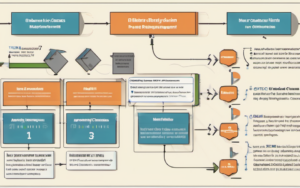Unlocking the potential of smart contracts requires understanding their intricate relationship with blockchain technology. This powerful combination is revolutionizing industries, offering unprecedented levels of security, transparency, and automation. Let’s delve into how blockchain empowers these self-executing agreements.
1. Introduction to Smart Contracts
1.1 What are Smart Contracts?
Smart contracts are self-executing contracts with the terms of the agreement between buyer and seller being directly written into lines of code. This code lives on a distributed ledger, automatically executing the agreement when predefined conditions are met. Think of them as automated agreements, eliminating the need for intermediaries and significantly reducing the risk of fraud. They’re built on trust, not on the trustworthiness of a single party.
This automated nature is a key differentiator. Instead of relying on manual processes and potentially fallible human intervention, smart contracts enforce themselves based on pre-programmed logic. This eliminates delays and disputes commonly associated with traditional contracts.
1.2 How Smart Contracts Work
At their core, smart contracts operate based on “if-then” statements. If a specific condition is met (e.g., payment received), then a predetermined action is triggered (e.g., transfer of goods or services). This logic is encoded in a programming language like Solidity and deployed onto a blockchain. The blockchain’s distributed nature ensures the code is transparent and immutable, making manipulation practically impossible. Understanding smart contract functionality on blockchain is crucial to utilizing their full potential.
The process involves defining the contract’s terms, writing the code, deploying it to a blockchain network, and then monitoring its execution. Each step is verifiable and transparent, enhancing accountability and trust.
1.3 Benefits of Using Smart Contracts
The advantages of implementing smart contracts are numerous. Firstly, they drastically reduce transaction costs by eliminating intermediaries. Secondly, they enhance security by leveraging the immutable nature of the blockchain. This eliminates the risk of fraud or manipulation. Thirdly, automation increases efficiency and speed, streamlining processes and reducing delays. Benefits of using blockchain for smart contract development are substantial, leading to a more transparent and trustworthy ecosystem.
2. Blockchain’s Role in Smart Contracts
2.1 Decentralization and Transparency
Blockchain’s decentralized architecture is pivotal to smart contracts. Instead of relying on a central authority, the contract code resides on a network of computers. This eliminates single points of failure and increases transparency, as all participants can view the contract’s code and execution history. How blockchain technology enables smart contracts is fundamentally linked to its decentralized nature.
This transparency builds trust and accountability. Everyone involved can track the contract’s progress and verify its execution, reducing the likelihood of disputes and ensuring fairness.
2.2 Immutability and Security
Once a smart contract is deployed on a blockchain, its code becomes immutable. This means it cannot be altered or deleted without consensus from the network. This immutability is a critical aspect of blockchain’s impact on smart contract security, preventing unauthorized changes and ensuring the integrity of the agreement. Any attempt to tamper with the contract is immediately detectable.
This characteristic is a significant advantage over traditional contracts, which can be easily manipulated or altered. The immutable nature offers a high level of security, making smart contracts ideal for high-stakes transactions.
2.3 Automation and Efficiency
Smart contracts automate the execution of agreements. Once predefined conditions are met, the contract automatically executes, eliminating manual intervention and reducing processing time. This automation streamlines workflows, increases efficiency, and reduces costs associated with manual processing.
This efficiency translates to significant time and cost savings, particularly in complex transactions involving multiple parties. It also reduces human error, which is a common cause of delays and disputes in traditional contracts.
3. Smart Contract Development and Deployment
3.1 Choosing a Blockchain Platform
Selecting the right blockchain platform is crucial for smart contract development. Factors to consider include scalability, security, transaction fees, and the availability of developer tools. Popular platforms include Ethereum, Hyperledger Fabric, and EOS, each offering unique features and advantages. Smart contract development using blockchain platforms requires careful consideration of these factors.
The platform’s community support and documentation are also important factors. A robust community can provide valuable assistance during the development process, while comprehensive documentation simplifies the learning curve.
3.2 Writing Smart Contract Code
Smart contract code is typically written in high-level programming languages like Solidity (for Ethereum) or other platform-specific languages. Developers need to carefully design the contract’s logic, ensuring it accurately reflects the terms of the agreement and is resistant to potential vulnerabilities. This step requires meticulous attention to detail and a deep understanding of programming best practices.
Thorough testing is essential to identify and fix any bugs before deployment. The consequences of bugs in a smart contract can be severe, so rigorous testing is crucial.
3.3 Testing and Deployment
Before deploying a smart contract to a live network, thorough testing is essential. This involves running various scenarios and simulations to identify and fix any potential bugs or vulnerabilities. Testing can be done on test networks before deploying to the mainnet.
Deployment to the blockchain involves submitting the compiled smart contract code to the network. Once deployed, the contract is publicly accessible and begins executing according to its programmed logic.
4. Real-World Applications of Smart Contracts
4.1 Supply Chain Management
Smart contracts are transforming supply chain management by enhancing transparency and traceability. Each step in the supply chain can be recorded on the blockchain, providing a verifiable audit trail. This improves efficiency and reduces the risk of fraud or counterfeiting.
This improved transparency enables better inventory management, faster delivery times, and reduced costs associated with tracking and verification.
4.2 Healthcare
In healthcare, smart contracts can streamline processes such as insurance claims processing and medical record management. They can also facilitate secure data sharing between healthcare providers and patients, while ensuring data privacy and security.
This improved efficiency and security can lead to better patient care and reduced administrative costs.
4.3 Finance
The financial sector is another area where smart contracts are finding increasing applications. They can automate loan processing, facilitate faster and more secure cross-border payments, and even enable the creation of decentralized exchanges (DEXs).
These applications can significantly improve efficiency, transparency, and security in the financial industry.
5. Security Considerations for Smart Contracts
5.1 Common Vulnerabilities
Smart contracts, despite their security advantages, are still susceptible to vulnerabilities. Common vulnerabilities include reentrancy attacks, arithmetic overflows, and denial-of-service attacks. Understanding these vulnerabilities is crucial for developing secure smart contracts. These vulnerabilities can lead to significant financial losses or data breaches.
These are not inherent weaknesses of blockchain technology itself, but rather issues stemming from poor coding practices.
5.2 Best Practices for Secure Development
Developing secure smart contracts requires following best practices throughout the development lifecycle. This includes using secure coding practices, conducting thorough code reviews, and employing formal verification techniques.
Regular security audits are also crucial to identify and address potential vulnerabilities before deployment.
5.3 Auditing and Verification
Independent security audits are vital for ensuring the security of smart contracts. Professional security auditors can identify potential vulnerabilities and suggest improvements to enhance the contract’s security posture. Auditing and verification help to mitigate risks associated with deploying smart contracts.
This rigorous process provides an additional layer of assurance, reducing the risk of exploitation and strengthening trust in the system.
6. The Future of Smart Contracts and Blockchain
6.1 Emerging Trends
The future of smart contracts looks bright, with several emerging trends shaping their evolution. These include the development of more user-friendly development tools, increased adoption across various industries, and the integration of artificial intelligence (AI) for improved decision-making.
Interoperability between different blockchain platforms is also a key area of development, allowing smart contracts to operate across various networks.
6.2 Potential Challenges
Despite the enormous potential, challenges remain. Scalability issues, regulatory uncertainties, and the need for greater user education are some of the hurdles that need to be overcome. Addressing these challenges is crucial for the widespread adoption of smart contracts.
Overcoming these challenges will unlock the full potential of smart contracts and revolutionize how agreements are made and executed. The future holds immense promise for smart contracts, promising a more efficient, transparent, and secure world of automated agreements.




